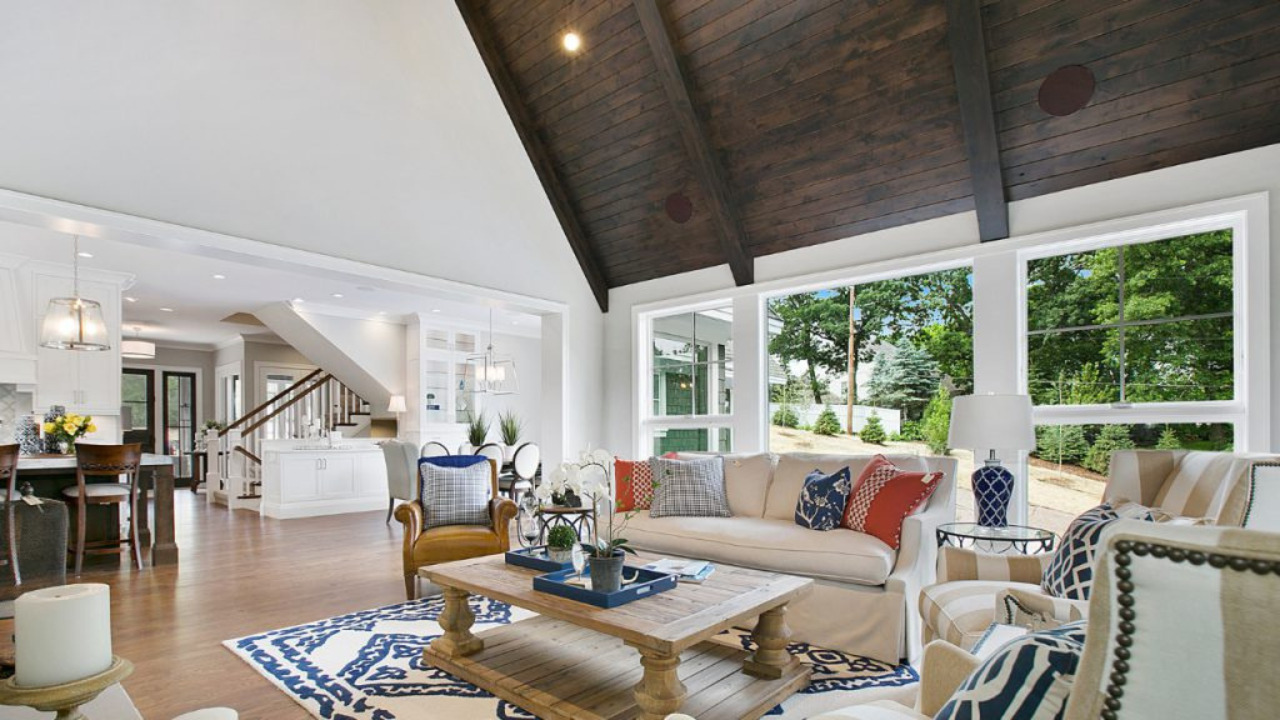Back in the times when the roots of ancient architecture were sprawling across lands and borders, people had limited options for decorating their home interiors. There came a time when knowing how to texture a ceiling was all the hype. This began subsiding as innovative and versatile architectural ceiling styles sprung up.
As of now, homeowners have a plethora of options in store when it comes to upgrading their homes. One such option is the tray ceiling. These ceilings especially are overlooked and are an afterthought when it comes to interior design.
Nowadays, different ceilings are installed to give an integrated look to your interior. These ceiling types range from rafter ceilings (that feature wooden rafters spaced at intervals across the inclined roof) to coffered ceilings (characterized by interconnected sunken panels).
Let’s find out more details about the tray ceiling, its types, installation, cost, and much more!
Table of Contents
What is a Tray Ceiling

A tray ceiling comprises a tray-like panel embedded in the ceiling upside down. The inverted tray overhead creates a single, large recess in the ceiling, unlike coffered ceilings. The coffered ceilings feature multiple recesses connected to form a geometric pattern or grid.
The architectural style of tray ceilings adds depth and visual attraction. It is rather unique from other types of ceilings. The central portion of a room can either be elevated or recessed, by providing a step in the ceiling, depending upon the desired look.
The more common look is a stepped interior concerning a slightly elevated ceiling periphery. The other one is less common and has a protruded central portion.
What Does a Tray Ceiling Look Like
The tray ceiling, also known as recessed or inverted ceiling, looks like a large upside-down tray. In other words, a tray ceiling looks like more than one flat horizontal ceiling surface at the same level. It also adds a three-dimensional effect to the room. Currently, tray ceiling is making a comeback and is considered a great choice due to its ability to enhance visual appeal.
What is The Purpose of a Tray Ceiling
The purpose of providing a flipped tray is to enhance the appearance of the room by giving an effect of spaciousness and adding height to the living space. Apart from this, the embedded or depressed area can effectively be utilized for incorporating decorative elements such as lighting, fixtures, ceiling fans, etc.
A tray ceiling is like an empty canvas; you can play with it in multiple ways. Some of the ways to accentuate tray ceiling are:
- Imparting coherent hues
- Attach decorative molds
- Painting tray ceiling using contrasting colors
- Using special lighting effects.
4 Common Types of Tray Ceilings
Tray ceilings entail a variety of architectural styles of the recessed portion. The following are a few common types of tray ceilings to consider.
1. Simple Tray Ceilings

These ceilings are characterized by a single step or recession, often wide enough to cover a vast area of the ceiling. The original ceiling height prevails in the periphery of the sunken panel to add visual depth to the interior.
2. Stepped Tray Ceilings

In stepped tray ceilings, the tray or recession is formed in multiple steps instead of a single one. That is why this ceiling type is also called a multi-level tray ceiling. The steps give a layered effect to the ceiling that looks super classy and is never getting old anytime soon.
3. Domed Tray Ceilings

In domed tray ceilings, the central portion is raised in the form of a dome or curve. The tray periphery is present at a lower level than the focal dome. These ceilings add a touch of elegance by giving a traditional and historic look. In historical times, painting high ceilings such as this one catered much time and cost.
4. Cove Tray Ceilings

Cover tray ceilings are those in which the central tray portion or recess is not flat but curved inwards with a gentle or pronounced curvature depending upon your architectural preference.
The Style and Effect of Tray Ceilings to Consider
The architectural design of tray ceilings requires attention to detail and precision. Some basic factors affecting design are as follows.
1. Ceiling Height
Installing a tray ceiling in a room that already has a small clear height might seem like adding depth to the interior but it results in space congestion and incoherence. A room’s height plays a crucial role in proportioning a tray ceiling.
A lesser height means limited design flexibility. You might have to resort to shallower ceilings or other different types of ceilings in-store.
More intricate, deep, and expansive trays can be formed in a ceiling if the clear height within your room is ample. Usually, this practice is implemented for the living and drawing rooms.
2. Tray Shape and Size

The layout of the tray ceiling will have a bearing effect on the available ceiling area. The tray shape and geometry should complement the ceiling space to create an integrated effect. Tray ceilings can be of different shapes including:
- Square
- Rectangle
- Octagon
- Irregular.
However, be mindful that none of the tray shapes should impact the flow of the space. Sme of the factors to consider while designing tray ceilings are.
3. Tray Depth
The tray depth is an important design factor and affects the overall ceiling. While deeper trays might look entrancing, shallower ones are a treat for the eyes in their classic way. The tray depth is determined mostly by the ceiling height of the room. Deeper trays also allow for greater flexibility in architectural style.
4. Tray Style
The prevailing design aesthetics inside a room must be focused on while deciding the architectural style of the tray. The overall look should not appear odd regardless of the tray style.
5. Addition of Decorative Elements

Tray ceilings offer the liberty of further customizing the ceiling with add-ons such as decorative elements, lighting fixtures, etc. Often, subtle lighting is attached to the recessed portion of the ceiling to brighten up the interior with a sublimed effect. Installing a chandelier seems an appealing option also.
Installation of Tray Ceilings
Depending on whether the tray ceiling installation was added during the home’s construction or following a remodel, there are differences in the tray ceiling installation procedure.
For Fresh Building
Your contractor will make arrangements for tray ceiling installation during the initial stages of building your home, eliminating the need to lower the ceiling height to make room for the drop-down border. If the builder chooses to order roof trusses rather than stick-framing, the truss manufacturer will engineer the trusses to allow for the tray ceiling. Stick framing and truss placement are tasks best left to the expertise of building specialists.
For Remodeling Ceiling
It is necessary to change the ceiling joists or trusses to recess a tray ceiling installation within an existing ceiling. This should only be done after seeking advice from a structural engineer or the roof truss manufacturer. Changing the framing might not always be structurally sound. Because the home’s structure is changing, permits are also needed for this modification. This is entirely a professional job.
Installing a drop-down tray ceiling is far easier if ceiling height permits than it is if the tray must be recessed inside the joists or trusses. It entails building the tray ceiling border’s drop-down frame, which is subsequently finished and covered with drywall. A competent do-it-yourselfer with some carpentry experience could be able to construct this kind of tray ceiling.
For False Ceiling
If you want to construct a false tray ceiling, you can install it yourself by painting the middle of the ceiling a different color than the surrounding border to give the impression that it has three dimensions.
What is Tray Ceiling Cost
The cost of a tray ceiling can depend on your choice of tray. The installation job can cost you from a few hundred to several thousand dollars. On average, the installation cost of a single tray can range from $1500-$3000.
For instance, shallow-depth, single-step tray ceilings will be less costly in comparison to deeper or multi-layered tray ceilings.
The size and complexity of the installation process also influence the cost of tray ceilings. Other than this, the quality of individual materials also determines the cost of tray ceilings. The common materials used for tray ceilings are drywall, wood, molding, and paint.
Also, additional finishing or decoration can alter the cost.
Elevate Space with Tray Ceilings
Tray ceilings can have a great impact on your home’s visual appeal as well as can impact its functionality. From adding a luxurious and attractive visual appeal to making the room feel larger and providing more lighting opportunities, these ceilings are a good option to consider.
On the bright side, they are also available in a variety of designs and materials. However, the choice of a tray ceiling is dependent on many factors such as ceiling height, tray shape, tray depth, etc. This is why it is advisable to choose an experienced and skilled contractor for the services.





